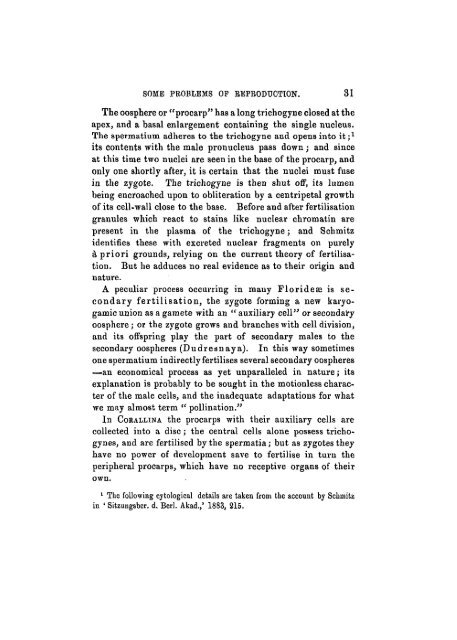Some Problems of Reproduction: a Comparative Study of ...
Some Problems of Reproduction: a Comparative Study of ...
Some Problems of Reproduction: a Comparative Study of ...
You also want an ePaper? Increase the reach of your titles
YUMPU automatically turns print PDFs into web optimized ePapers that Google loves.
SOME PROBLEMS OF REPRODUCTION. 31<br />
The oosphere or "procarp" has a long trichogyne closed at the<br />
apex, and a basal enlargement containing the single nucleus.<br />
The spermatium adheres to the trichogyne and opens into it ; l<br />
its contents with the male pronucleus pass down j and since<br />
at this time two nuclei are seen in the base <strong>of</strong> the procarp, and<br />
only one shortly after, it is certain that the nuclei must fuse<br />
in the zygote. The trichogyne is then shut <strong>of</strong>f, its lumen<br />
being encroached upon to obliteration by a centripetal growth<br />
<strong>of</strong> its cell-wall close to the base. Before and after fertilisation<br />
granules which react to stains like nuclear chromatin are<br />
present in the plasma <strong>of</strong> the trichogyne; and Schmitz<br />
identifies these with excreted nuclear fragments on purely<br />
& priori grounds, relying on the current theory <strong>of</strong> fertilisation.<br />
But he adduces no real evidence as to their origin and<br />
nature.<br />
A peculiar process occurring in many Florid ese is secondary<br />
fertilisation, the zygote forming a new karyogamic<br />
union as a gamete with an " auxiliary cell" or secondary<br />
oosphere; or the zygote grows and branches with cell division,<br />
and its <strong>of</strong>fspring play the part <strong>of</strong> secondary males to the<br />
secondary oospheres (Dudresnaya). In this way sometimes<br />
one spermatium indirectly fertilises several secondary oospheres<br />
—an economical process as yet unparalleled in nature; its<br />
explanation is probably to be sought in the motionless character<br />
<strong>of</strong> the male cells, and the inadequate adaptations for what<br />
we may almost term " pollination."<br />
In C<strong>of</strong>tALUNA the procarps with their auxiliary cells are<br />
collected into a disc; the central cells alone possess trichogynes,<br />
and are fertilised by the spermatia; but as zygotes they<br />
have no power <strong>of</strong> development save to fertilise in turn the<br />
peripheral procarps, which have no receptive organs <strong>of</strong> their<br />
1 The following cjtological details are taken from the account by Schmitz<br />
in ' Sitzuugsber. d. Berl. Akad.,' 1883, 215.

















